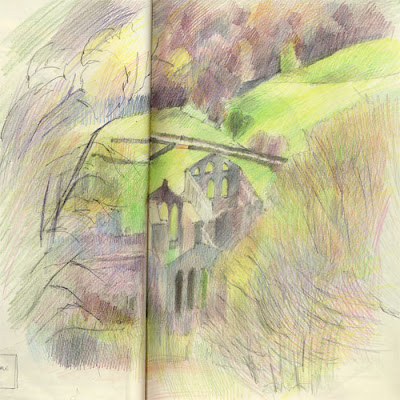 Nocturne: Blue and Silver - Chelsea
Nocturne: Blue and Silver - ChelseaJames McNeil Whistler
Oil painting on wood
support: 502 x 608 mm frame: 685 x 825 x 45 mm
Bequeathed to the Tate Gallery, London by Miss Rachel and Miss Jean Alexander 1972
James McNeil Whistler is the artist of choice for the Fine Line Artists' Group Project in May
Art should be independent of all claptrap —should stand alone [...] and appeal to the artistic sense of eye or ear, without confounding this with emotions entirely foreign to it, as devotion, pity, love, patriotism and the like (Whistler)Here's some links to kick off with:
- Freer Gallery of Art - including the Interactive Introduction to Whistler and his art
- Freer Gallery: Small masterpieces - Whistler paintings from the 1880s
- Freer gallery - Art for Art's sake
- Whistler at the Metropolitan Museum of Art
- Whistler House Museum of Art, Lowell Massachusetts - birthplace of James McNeil Whistler
- An account of the Whistler/Ruskin affair
- Tate Collection: James Abbot McNeil Whistler
- Glasgow Uuniversity: Centre for Whistler Studies
- Glasgow University: the correspondence of Whistler (on-line)
- Artchive - Whistler
- Artcylopedia - Whistler
- Atheneaum - Whistler
- Wikipedia - James McNeil Whistler 1834 - 1903
- Wikipedia 'art for art's sake' Whistler's statement of why art should not be subordinated to the service of the state or religion.
The expatriate American artist James McNeill Whistler was born in Massachusetts, studied art in Paris from 1855 to 1859, and spent most of the rest of his life in London. As an art student,Whistler was strongly influenced by seventeenth-century Dutch and Spanish art, and by the realism of Gustave Courbet (1819–1877).I think that makes 4 artists out of 4 so far who've been influenced by the Japanese Prints which began to circulate in the late nineteenth century. Do you get the impression we're going to have to have a project about these too?Whistler first achieved critical and commercial success as an etcher, producing meticulously drawn prints of working-class life in rural France and London. His earliest important oil paintings evidence Courbet's influence, featuring the commonplace subjects and vigorous brushwork characteristic of the older artist's work.........
Whistler's art changed dramatically in the 1860s. Influenced by Greek sculpture, Asian porcelain, and Japanese prints, he rejected the idea that the success of an art object could be measured by its accuracy as a representation or the effectiveness with which it told a story or suggested a moral. Instead, he became convinced that an art object was best understood as an autonomous creation to be valued only for the success with which it organized color and line into a formally satisfying and therefore beautiful whole. Abandoning the idea that paintings should create the illusion of pictorial depth, he developed the flatter, more purely decorative style for which he is best known...........(in the) early 1870s, when Whistler began to paint the moody night scenes and restrained portraits which made him famous. (Freer Gallery of Art)
 Exhibitions in which I've seen Whistler paintings include the 'Americans in Paris' exhibition at the National Gallery in February 2006 and the Turner, Whistler and Monet exhibition in the Grand Palais in Paris in October 2004 (on the left is the queue - it took us 35 minutes to reach the front of this). I remember being particularly struck by how many titles involved a colour.
Exhibitions in which I've seen Whistler paintings include the 'Americans in Paris' exhibition at the National Gallery in February 2006 and the Turner, Whistler and Monet exhibition in the Grand Palais in Paris in October 2004 (on the left is the queue - it took us 35 minutes to reach the front of this). I remember being particularly struck by how many titles involved a colour.Other resources I shall be using include:
- the catalogue for the Turner, Whistler and Monet exhibition (Publisher: Tate Publishing (10 May 2004); ISBN-10: 1854375008; ISBN-13: 978-1854375001)
- "Whistler's Venice" by Alastair Grieve - about his production of etchings, oils, pastels and drawings of the city of Venice. It contains much about his methods and techniques and is approach to being a topographical artist. (Published by the Paul Mellon Centre for Studies in British Art by Yale University Press ISBN 0-300-08449-8)
As`with our previous projects, please feel free to join in if you'd like to. Just leave a comment on one of the Whistler posts in this blog or those of Maggie Stiefvater, Nicole Caulfield or Wendy Prior if you'd like to be included in the roll call of participants.
Links:
Technorati tags:
















